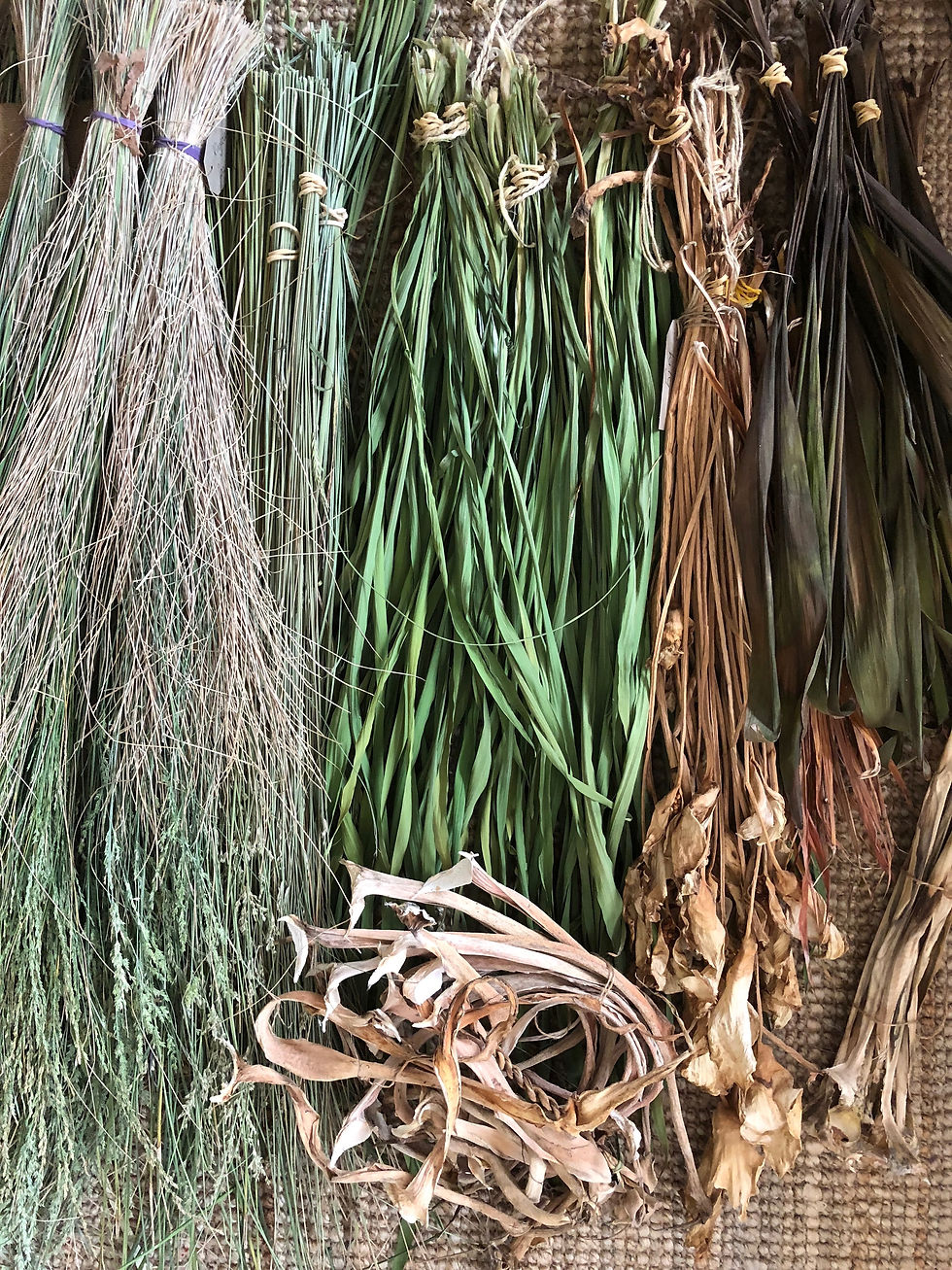How to Prepare Plant Fibre for Weaving
- Ruth Woods

- Feb 21, 2024
- 5 min read
Updated: Sep 10
It seems to me that the natural world is the greatest source of excitement; the greatest source of visual beauty; the greatest source of intellectual interest. It is the greatest source of so much in life that makes life worth living. - David Attenborough
If you are about to start your basketry journey using plants you will never look at plants the same way again! If you have already started this journey then you know how exciting plants can be!
Learning about plants for natural basket weaving has many variables…the climate, the environment and the seasons - all the beauty of nature! 🌞🌄 Plants can look very similar but react very differently when picking, drying and preparing.
If you live in a temperate climate you might use grasses and strappy plants such as Red hot poker, Day lilies, NZ flax, various rushes and vines. If you live in the subtropics you could access Banana fibre, Palm inflorescence, Cordyline and so much more. Vines will grow in all climates and are ideal for basketry and there are so many different species that are exciting to use.

In this article we will cover these common questions:
This is a really comprehensive guide to share with others!
Where do I find plants for weaving?
Get ready to see plants everywhere! Once you start looking for suitable plants a whole new world opens up and it is totally captivating!
Investigate what you currently have in your garden - you may be surprised at the variety of possible fibres and stems you can use.
Walk in your neighbourhood and observe what’s around, make friends with your neighbours, have a chat and talk to them about plants in their garden telling them what you do with plant fibre. People are always fascinated that you can make baskets with plants. 🤯🌿
Talk to the gardener at the local park or botanical gardens. They often have garden waste that can be incorporated into a basket.
If you are looking for something in particular, post in a local community Facebook group and ask if anyone is pruning the plant you’re looking for or visit your local plant nursery.
Make sure you know the local laws, check your local council about picking plants on the side of the road. National Parks have strict rules about picking plants and usually it’s illegal unless you have a permit.

How do I know what to pick?
Oh the choices! You will soon have your favourites!
There is a so many plants to pick from and try -- far too many to list here. Don’t be afraid to try them out.
A great indicator to work out which plants are suitable is to scrunch the dead leaves at the base of the plant in your hand and see if they stay intact. The best time to do this is early in the morning when they’re still moist from the dew or after it has rained. This will give you a great idea of what they are like to work with.
Many people ask if they can use Agapanthus but sadly there is no fibre in the leaf and it cannot be used.
Plant fibres that are friendly and soft to your hands make working with them a pleasure. Avoid using fibres with rough edges or prickles that might give you splinters. Wear gloves if you find something rough on your hands.
Long leaf, soft fleshy plants like Daylily, Daffodil, Red hot poker are beautiful soft fibres and a pleasure to work with. They rehydrate quickly with a quick soak in water.
Many grasses are ideal too. Choose the ones that are softer to touch as some can be very sharp and can cut your hands. Tussock grass is good for bulk in coiled baskets.
Numerous vines and creepers can be use for basketry. Some will give you a smooth look and others can be textural and knotty. When collecting vines you can pull the runners out to
a few metres - it’s always very exciting when you find a long one to wind into something magical!

When is the best time to pick plants?
Picking plants will depend on the time of year.
Plants generally die back in the winter and sprout in the spring. However in warmer climates this is different - so as you observe the plants around take note what they do and experiment with the fibre.
In the spring you will find that various rushes pop up as well as other strappy plants. These are best picked in the summer.
Flowering plants are best picked after they have flowered and some plants are good to pick all year round.

How do I dry the plants?
Drying varies depending on the thickness and density of the plant and the climate where you live. A fine leaf plant like a daylily or daffodil can take little time to dry. Plants like Arum lilies and Iris’s with thicker structures will need a lot more time to dry out, sometimes months.
Depending on the shape of the leaves, make small bundles and hang for as long as they take to dry. Shorter leaves can be laid out on a table and turned regularly to allow air circulation.
Some leaves will dry on the plant or fall to the ground; these leaves can be picked and
used immediately after soaking. They include…Philodenron leaf sheaths, Jacaranda leaf stalks, Agave attenuate leaves, Dracaena draco and Dracaena marginata, Palm inflorescence,
Cordyline australis. I’m sure you can discover more.
How do I store my plants?

Storing is important and again depending on where you live will depend on how you store your fibre. Once they are dry store them in a laundry, utility room, garage or dry shed. You need to try and avoid humidity as much as possible. Some basket makers have fibres hanging all over the house!
If you live in the tropics or a climate that has high humidity make sure you store in an airy place or the fibre will go mouldy. Use a tag and write the date you picked them, the location and the name of the plants as many of them look similar when dried.
How do I rehydrate the plant so I can use it?
Only rehydrate the materials you think you’ll use. If you wet too much fibre you could waste it.
A general rule - if a fibre is fine it will not take much moisture to make it pliable to work with. Some fibres are very absorbent like banana fibre, palm spathes, and fine leaves such as Day lilies and Daffodils which are quick to rehydrate.
Fine leaf fibres generally will need to be run under a tap or dipped in a tub of water for maybe two minutes. If the fibre is not pliable leave for longer. If fibres are thicker then soak up to a couple of hours and with plants like Agave leaves and thick vines could take 24 hours to become pliable.
Try and use the fibre you have moistened within a day or two. If you over soak the fibres they will absorb too much water and then shrink when they dry out.
What ever you choose to create don’t be afraid to make mistakes - we not only learn from our mistakes but it’s where we find beautiful inspired ideas.
Creativity is inventing, experimenting, growing, taking risks, breaking rules, making mistakes, and having fun.” – Mary Lou Cook.
Tell us in the comments what your favourite plant fibres are to work with and why! We would love to hear your stories and you can inspire others to try them as well 🪴🌿💚














Has anyone had any experience using air potato (dioscorea bulbifera) vine? Horribly invasive in the U.S., and, unfortunately, my yard.
I found that Morning Glory vine, which is an invasive weed in NSW, makes fantastic leather-like cord, which if perfect for tying gods-eye knots and also for very tight weaving. It doesn't snap or break, and can be found in long lengths which coil easily. It dries to a soft pinky colour and seems to get stronger with age. One just has to be careful if pulling it from trees because it can snap foliage. Better to pull from the ground.
I first harvested lomandra and dried it, but it was hard as wire, then discovered when I split it before drying, the strands were a lot more manageable for weaving. I should have watched the elders doing it!! Same with cumbungi - it's so fat and thick but I couldn't be bothered to peel it back to remove the pith like others do. I twist the fat leaves and use for weavers on baskets and they're nice and chunky. But my favourite is three-side clubrush (or bogrush?) from my dam which is so deliciously squishy to work with and make cordage from
I live near Charleston SC USA where Gullah weavers are keeping alive the traditional basketry of their ancestors. They use sweetgrass and a very specific palm frond, both of which grow here. I am now growing my own sweetgrass and have been gifted a large bundle to practice with. After taking several of your courses, I now feel that I am truly on my way to becoming a master of basketry of my own style, even if it takes many years! I have all the materials that I need here in my suburban yard: pine needles, sweetgrass, day lilies, irises, daffodils, and various similar plants I don't know the names of. I buy a few things, such as sinew an…
Many thanks for such clear info- I have split and stored NZ flax, here in Scotland but in an unheated shed and they are now mouldy! Are these recoverable or lost?? So much to learn!!!